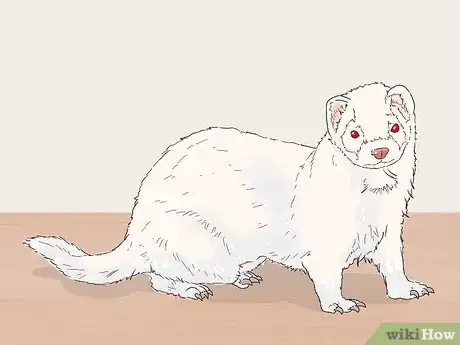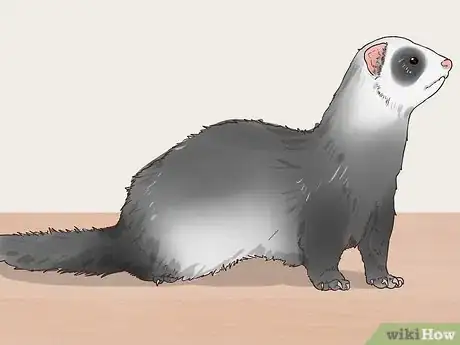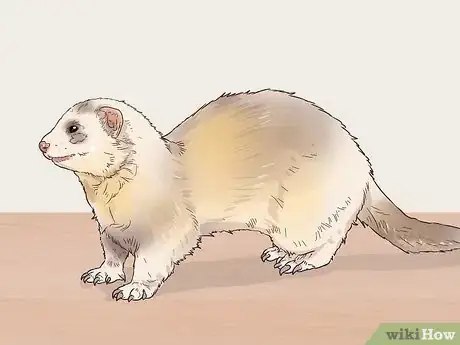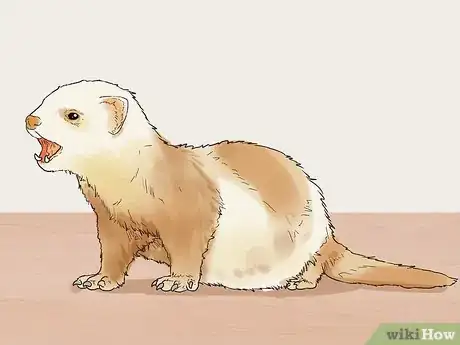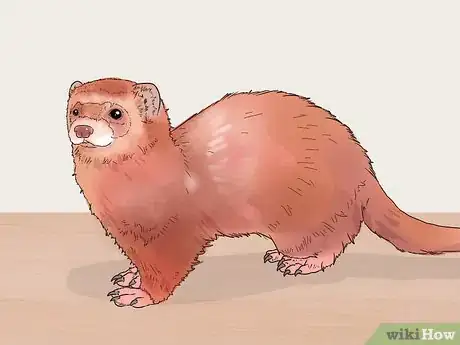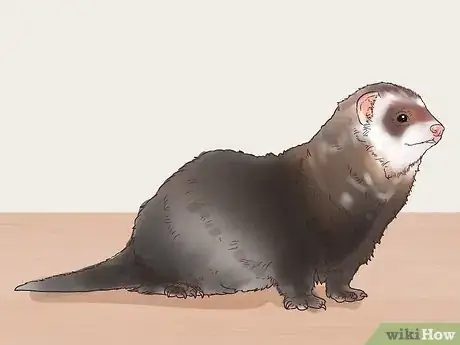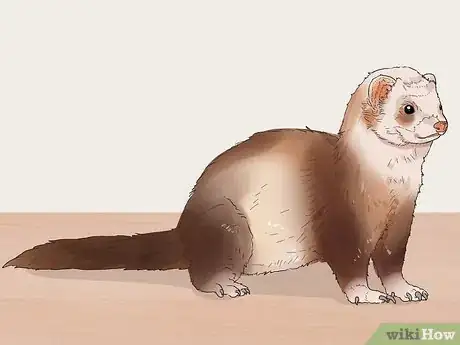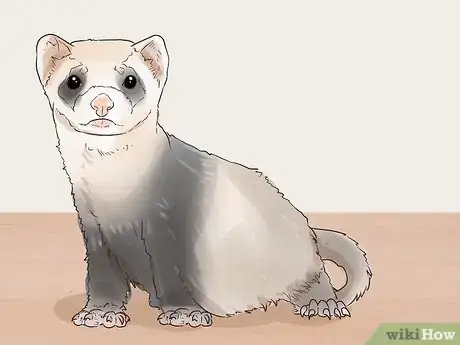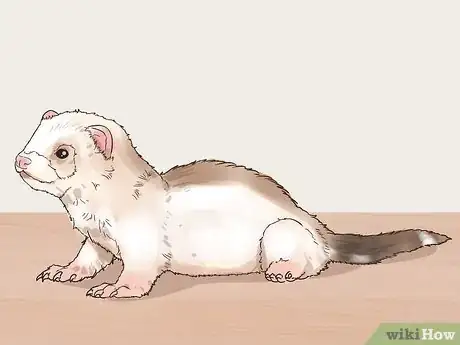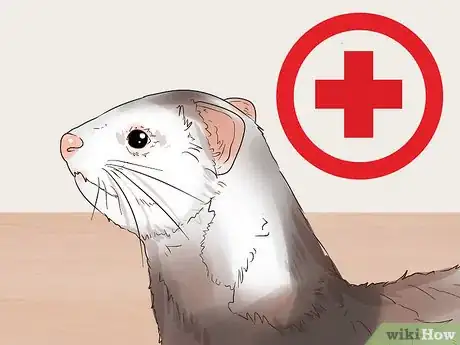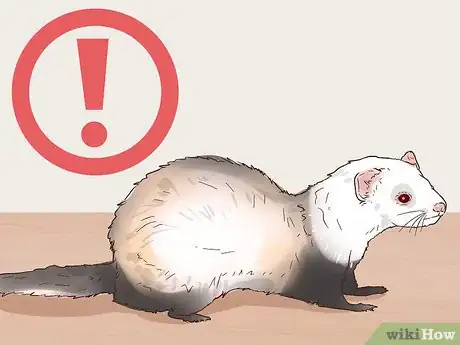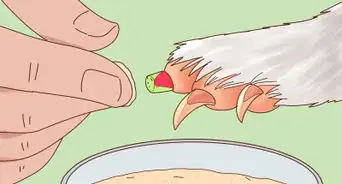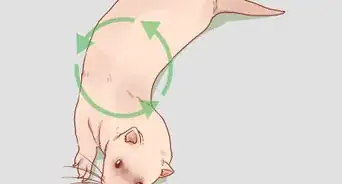This article was co-authored by Melissa Nelson, DVM, PhD. Dr. Nelson is a Veterinarian who specializes in Companion and Large Animal Medicine in Minnesota, where she has over 18 years of experience as a veterinarian in a rural clinic. She received her Doctor of Veterinary Medicine from the University of Minnesota in 1998.
This article has been viewed 16,997 times.
Ferrets make great pets, as they are intelligent, playful, and have beautiful coats. As a prospective pet owner, you may be overwhelmed by the variety of colors and coat patterns found among ferrets. You can choose from ferrets who have a solid coloring or ferrets who have patterns on their coats. Make sure you pick a ferret who has colouring and patterns that fit your preferences and needs.
Steps
Selecting the Ferret's Coloring
-
1Get an albino ferret if you like a white coat. Albino ferrets are known for their pure white fur and pink or red eyes. They have beautiful pure white coats that will stay white their entire lives. They are often used as therapy pets, as they are easy to spot.[1]
- Get an albino ferret if you don't mind some extra cleaning. Albino ferrets will need to be bathed once a month to maintain their white coats. However, you should not bathe them more than once a month, as this can cause skin and coat problems.
- Albino ferrets will also shed white hair on your clothing, so be prepared to avoid wearing black and dark colored clothing around your ferret. You will also need to have a lint brush handy to remove the white hairs.
-
2Pick a black sable ferret if you'd prefer a darker coat. Black sable ferrets have a deep black color from nose to tail. They have dark brown guard hairs and a white or creamy undercoat. They are a great option if you'd like a ferret with a darker, richer looking coat.[2]
- Hair guards are the layers of hair on the outside of your ferret.
- Sable ferrets are a good option if you tend to wear dark clothing, as their hairs will not show up as noticeably.
- Sable ferrets can be more difficult to spot in a dark room than albino or silver ferrets due to their dark coats.
Advertisement -
3Choose a silver ferret if you like a grey coat. Silver ferrets have beautiful grey or silver guard hairs and a white undercoat. They are a good option if you want a ferret with a light grey coat.[3]
-
4Get a champagne ferret if you'd prefer a light brown coat. Champagne ferrets have milk chocolate guard hairs and white undercoats. They may also have a light brown or beige “T” outline around their eyes.[4]
-
5Go for a cinnamon ferret if you like a reddish coat. Cinnamon ferrets have reddish brown guard hairs, giving them a pleasant cinnamon coloured coat. They also usually have burgundy eyes and a dark red or brown nose.[5]
- Cinnamon ferrets are considered more rare than other varieties, like sable or albino, and may be more expensive.
Picking the Ferret's Coat Pattern
-
1Choose a ferret with a solid or standard pattern for more even colouring. A solid pattern can be any coat color except for all white. The coloured guard hairs will be 100% one color with no white guard hairs. Ferrets with this pattern will appear as one color from head to tail and have a mask that is full white or in the shape of a T.[6]
- The standard pattern is similar to the solid pattern, except the color concentration is not as heavy.
-
2Go for a ferret with a roan pattern for more variation. A ferret with a roan pattern will have a coat in any color except for white. It will have 40% to 60% white guard hairs on its body. It will also have coloured guard hairs sprinkled throughout its body.[7]
-
3Pick a ferret with a point pattern for high contrast. A ferret with a point pattern will have a coat that is any color except for white and have a distinctly different color concentration on its body and its points. This gives its coat a nice contrast between two colors.[8]
- A sable, cinnamon, or chocolate ferret with a point pattern may have a thin V-shaped mask on its face.
- A champagne ferret with a point pattern will have a thin V-shaped mask, or no mask at all.
-
4Select a ferret with a bib for a dash of white. The bib will appear as a half circle marking on the ferret's chest. You can find sable ferrets with bibs.[9]
-
5Pick a ferret with white mitts for an extra dose of cuteness. A ferret with white mitts will have white toes and feet. You can find sable and silver ferrets with white mitts.[10]
-
6Choose a ferret with irregular markings for a unique look. Albino ferrets can come with dark, irregular markings on their bellies and torso. They may also have rings around their tails. These irregular markings give albino ferrets a unique pattern to their coats.[11]
- An albino ferret that has a short tail with a ring is at risk of developing Waardenburg's Syndrome, which leads to deafness in ferrets.
-
7Watch for health issues if the ferret has a blaze. A blaze is a white streak that appears between the ears of the ferret. They usually appear on sable or Siamese ferrets. The streak may cover most of the ferret's head, extending to its shoulders. Ferrets with blazes are prone to congenital defects, such as deafness.[12]
- You may want to avoid getting a ferret with a blaze if you do not want to worry about the ferret being deaf, as up to 75% of ferrets with a blaze are deaf. This is because their hearing mechanism is underdeveloped as a result of a genetic condition called Waardenburg syndrome. This condition is linked with white markings on a ferret's face, which are most common on ferrets with blaze or panda markings.[13]
-
8Be cautious of a ferret with panda markings. A ferret with panda markings will have an all white marking on their head that extends to their shoulders as well as white mitts, a bib, and small patches of white on the front of their hind legs. These ferrets are beautiful to look at, but they are prone to medical issues like deafness.[14]
- Like with ferrets that have blaze markings, panda ferrets are also more likely to be deaf. This is because the genetic markers that give them their white markings can also cause underdeveloped hearing mechanisms in their inner ear.[15]
References
- ↑ https://www.coopsandcages.com.au/blog/ultimate-list-ferret-breeds/
- ↑ https://www.coopsandcages.com.au/blog/ultimate-list-ferret-breeds/
- ↑ http://ferretedu.weebly.com/ferret-colors.html
- ↑ http://ferretedu.weebly.com/ferret-colors.html
- ↑ https://www.coopsandcages.com.au/blog/ultimate-list-ferret-breeds/
- ↑ https://www.ferret.org/pdfs/Ferret_Colors_and_Patterns.pdf
- ↑ https://www.ferret.org/pdfs/Ferret_Colors_and_Patterns.pdf
- ↑ https://www.ferret.org/pdfs/Ferret_Colors_and_Patterns.pdf
- ↑ http://ferretedu.weebly.com/ferret-colors.html
- ↑ http://ferretedu.weebly.com/ferret-colors.html
- ↑ http://ferretedu.weebly.com/ferret-colors.html
- ↑ https://www.ferret.com/ferret-articles/what-color-is-my-ferret/3/
- ↑ http://www.cypresskeep.com/Ferretfiles/Deaf.htm
- ↑ http://www.peteducation.com/article.cfm?c=11+2072&aid=547
- ↑ http://www.cypresskeep.com/Ferretfiles/Deaf.htm
About This Article
To choose between ferret colors and coat patterns, consider how much time you want to spend maintaining your ferret's coat. For example, a lighter coat will need to be cleaned more often and will shed light hair that shows up on darker clothing. If you want your ferret to look unique, choose an albino ferret since they come with irregular markings on their bellies and torso. However, if your albino ferret has a short tail with a ring, it could be at risk of developing a syndrome which leads to deafness. For more advice from our Veterinary co-author, including how to identify markings that may indicate potential medical issues, keep reading!
